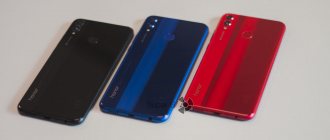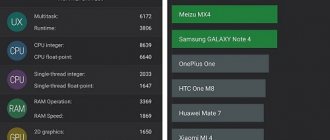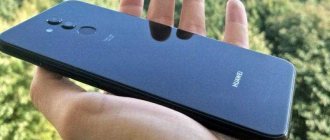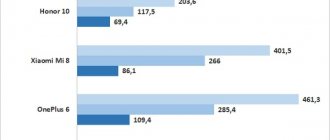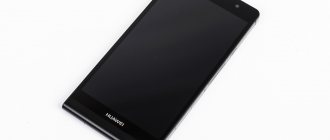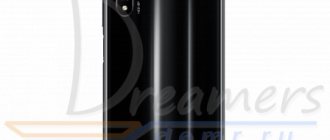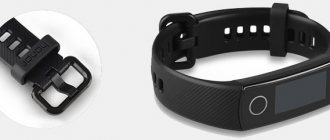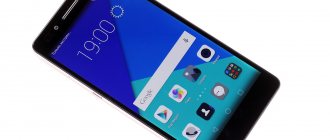The Honor line of smartphones is Huawei's second brand in the field of mobile devices. Its main difference is a more favorable price for top-end hardware. We'll review the Honor View 10 and show you what a user can get for $450. Looking ahead a little, let’s say that the main feature of the company’s new flagship is the latest neural network module. The device has a coprocessor with built-in machine learning and artificial intelligence. It is designed to make the life of the device owner easier in some areas of the device’s operation. For example, the processor can study the user’s behavior and provide him with intriguing news, recommend applications, as they say, ahead of his thoughts. In addition, the device in the future will be able to provide a good balance of autonomy and performance, based on operating experience.
Specifications
It is logical to assume that the characteristics of View Honor 10 are truly top-end and provide good performance. Huawei Honor View 10 has two modifications with 4 and 6 GB of RAM and 64 with 128 GB of main memory. All other characteristics are the same.
| Screen | 5.99 inches, LTPS LCD, 2160×1080 pixels |
| Battery | Non-removable, Li-Ion 3750 mAh |
| Platform | HiSilicon Kirin 970 |
| CPU | Octa-core (4×2.4 GHz Cortex-A53 + 4×1.8 GHz Cortex-A53) |
| Video accelerator | Mali-G72 MP12 |
| Inner memory | 64 GB and 128 GB |
| RAM | 4 and 6 GB |
| Memory card slot | Combined with SIM for micro-SD up to 256 GB |
| Main camera | 16 MP (f/1.8) and 20 MP (monochrome) |
| Front-camera | 13 MP, f/2.0 |
| Navigation | GPS, A-GPS, GLONASS, BDS |
| Sensors | Fingerprint scanner, IR remote control for controlling household appliances, light and proximity sensors, accelerometer, indicator light, display orientation sensor |
| Interfaces | Wi-Fi 802.11 b/g/n/ac, dual-band, Bluetooth 4.2 LE, USB Type C (USB 2.0), NFC |
| operating system | Android 8.0+EMIU 8.0 |
| Dimensions | 157x75.3x7.6 mm |
| Weight | 172 g |
Cameras Huawei Honor V10
The rear camera apertures are f/1.8, have phase detection autofocus, and support 4K video recording. The 13 MP front camera has an f/2.0 aperture. Huawei Honor V 10 review reveals the excellent photographic capabilities of the model, which we will talk about next.
At the top of the app is the flash toggle, wide aperture mode, portrait mode, motion picture mode, and settings. At the bottom there is a gallery, a shutter button and a transition to shooting video. Swiping to the left opens various shooting modes such as professional, HDR, black and white, night, slow motion, panorama, etc.
Example photo on Huawei Honor V10
In daylight, the device takes excellent photos with high clarity, but often oversaturated. Fans of vibrant multi-color photographs should be pleased. At times, during macro photography, detail is lost and photographs come out overexposed. Focus quickly captures the object, with the help of artificial intelligence the camera recognizes text, food, people's faces, and changes settings. Sometimes there is a lack of detail when shooting in HDR mode.
The camera performs best when shooting in black and white. Here photographs can turn out truly artistic. Portrait mode for front and back shots also works well. In low light, the results are quite good, although half of the images contain a fair amount of digital noise.
It supports 4K video recording at 30fps and 1080p at 60fps. The result is good, as is the sound quality in the video, which is helped by the second microphone. When shooting on the go, there is a lack of optical or electronic image stabilization.
The fingerprint scanner is located on the front. This allows you to quickly find it and unlock the device. You can store up to five fingerprints.
Performance
Huawei Honor V10 specifications include the use of an 8-core Kirin 970 processor, created on a 10 nm process technology, there is also an i7 coprocessor and a Mali-G72 MP12 GPU. As expected, the operating speed is the highest, at the level of the best flagships. The software and hardware components fit together perfectly and bring high speed. This also applies to multitasking thanks to the 6 GB memory. Even the most complex mobile games do not slow down your smartphone.
Synthetics:
Equipment
The Honor View 10 smartphone comes in a standard small cardboard box. Unfortunately, the Honor View 10's equipment is not particularly rich. Inside the box there is a smartphone, a charger, a clip for removing the SIM card tray, a USB cable and instructions . The manufacturer did not include any additional accessories, such as a case or a headset, in the box.
Design
It’s worth saying right away that the device looks stylish and expensive. Although this is a flagship, the body is not made of glass, as is now common, but of aluminum, which gives the body strength. The back panel is easily soiled and fingerprints easily remain on it. It's sad that the manufacturer didn't include any kind of silicone case with the smartphone; it needs one right out of the box.
The design of the case is pleasing: the rear metal panel smoothly flows into the front glass without any joints. I would like to note the excellent build quality, all the parts fit perfectly, nothing creaks or plays. As is customary for this brand, the colors of Honor View 10 are bright and varied. So, in addition to the standard black, there is also blue, gold, and there is even Honor View 10 in red.
On the front we have a large display with thin frames, which is covered with impact-resistant 2.5D protective glass. The fingerprint scanner is located under the screen, and not on the back panel, like most devices. This is a rather controversial decision, since such a location is not always convenient.
Above the screen there is a front camera, a speaker for conversation, a notification indicator and light sensors. The “Honor” inscription appears at the bottom. On the back panel you can find a dual camera and flash, they are slightly convex. There are narrow plastic inserts at the bottom and top, which are designed for wireless modules and the antenna, so that their functionality is not impaired due to the metal layer.
On the right there are standard volume control buttons and a power key. On the left is a tray for a memory card and SIM card. On the bottom edge there is a built-in USB Type-C port, a headphone jack, a main speaker and a second microphone for calls. On top of the device there is the first microphone and an infrared port, which allows you to use the smartphone as a remote control for equipment.
Minimal and comfortable
This review will often compare the View 10 to the Mate 10 Pro, and for good reason. Honor is an integral part of Huawei, so they share common technologies. The main difference between smartphones is the design.
The body is metal with a matte finish, the model in question was black, with antenna strips at the top and bottom. The Honor logo is in blue. The device has a minimalistic appearance; its appearance cannot be called luxurious.
Compared to other flagships like the Mate 10 Pro and OnePlus 5T, it's pretty bland. The fingerprint scanner is placed on the front; on the back there are only cameras that extend beyond the body by a couple of millimeters.
Apart from this, the smartphone is comfortable to hold in your hand, largely due to its lightness. The thickness of the case is only 6.97 mm, the back surface quickly gets dirty with fingerprints, so it is better to use a case.
If you put the View 10 next to the Mate 10 Pro, you can immediately see which smartphone is more expensive. If you value looks and hand feel, the difference is worth it. If this doesn't matter to you, then read on.
Display
How can a review of the Honor View 10 phone be complete without a description of the display? The device has a large 5.99-inch screen with a high resolution of 2160 by 1080 pixels. It has a high pixel density per inch - 407 ppi, so that the human eye can hardly distinguish them, which ensures high image quality.
The screen is covered with Corning Gorilla Glass and film from the factory; it has an oleophobic coating.
The picture quality is beyond praise, the colors are rich and rich, and the brightness of the smartphone display is enough to work on a sunny day. The viewing angles are excellent. However, due to the high gloss of glass, sunlight may reflect. It is advisable to use some kind of anti-reflective protector to ensure eye comfort.
Also, if there is not enough richness of colors, or, conversely, you want to mute them, there are flexible settings. There is automatic brightness adjustment and manual white balance adjustment. To increase the autonomy of the screen, you can lower its resolution; the difference will not be easy to notice the first time, so from the first days you can protect the battery from rapid wear.
Screen
The manufacturer saved on the screen. Or rather, the display in Honor View 10 is quite decent (5.99 inches, Full HD+ resolution, 18:9), it’s just that the matrix used here is the most common one - IPS. While all modern flagships receive OLED panels of various variations. Even Huawei Mate 10 Pro has this type of screen.
In any case, we have a very high-quality IPS matrix. Viewing angles, richness of colors, contrast - everything is at the usual, quite pleasant level.
Gorilla Glass 3 has a high-quality oleophobic coating, auto-brightness adjustment works well - there are no questions here.
Cameras
The View 10 smartphone received a dual camera, the main module of which has a resolution of 16 megapixels, and the second - black and white - has 20 megapixels. Two cameras - color and black and white - combine photos taken separately into one, and the result is a photo with minimal noise and a wide dynamic range. In addition, the neural network module improves autofocus and face detection, and controls other less noticeable functions that improve images.
Daytime photos are of the highest quality, and the HDR mode works more than properly. As a result, we have almost perfect photographs. In addition, there is a background blur mode, which gives an interesting effect to the photo.
It is worth adding about the presence of a real 2x zoom, which is carried out without loss of photo quality. The main feature of the rear camera is that even in poor lighting or at night, the pictures are of good quality. Overall, the camera turned out to be quite good without any noticeable disadvantages.
And the 13 megapixel front camera can’t boast of anything special. The pictures come out quite good, you don’t need more for a selfie camera.
The “Camera” application turned out to be intuitive and has just a huge number of settings: from ready-made options to manual fine adjustments.
The video from the front and main cameras is of good quality and high resolution, up to 4K at 30 frames per second.
Review of the Honor View 10 smartphone based on Kirin 970 with a neural processing unit (NPU)
At the end of last year, Huawei carried out another expansion of its Honor smartphone family, presenting a new View line in London. The Honor brand now produces the most affordable “Lite” series (budget lines Honor A and C) and the more expensive but well-proven Honor X line, and even higher in the hierarchy are products of the so-called “N” series - they are presented to end customers without any additional letters in the name, these are devices such as Honor 7, 8, 9. And now all this is crowned by the top-end Honor View series, or simply “V”, which we will talk about today.
Most recently, Huawei demonstrated to the world, using the Mate 10 Pro as an example, its new hardware solution in the form of SoC HiSilicon Kirin 970, made according to the latest 10 nm process technology and with a dedicated neural computing unit (NPU). So, almost immediately the manufacturer used this advanced platform for the flagship of the Honor family. The carrier of the latest SoC is the most powerful smartphone in the entire history of Honor called Honor View 10.
Main characteristics of Honor View 10 (model BKL-L09)
- SoC HiSilicon Kirin 970, 8 cores 4×Cortex A73 2.36 GHz + 4×Cortex A53 1.8 GHz
- GPU Mali-G72 (MP12)
- Operating system Android 8.0, EMUI 8.0
- Touch display IPS 5.99″, 2160×1080, 403 ppi
- Random access memory (RAM) 6 GB, internal memory 128 GB
- Nano-SIM support (2 pcs.)
- MicroSD support up to 256 GB
- GSM/GPRS/EDGE networks (850/900/1800/1900 MHz)
- WCDMA/HSPA+ networks (850/900/1900/2100 MHz)
- Networks LTE Cat.12/13 FDD (B1/3/5/7/8/20), TD (B38/40/41)
- Wi-Fi 802.11a/b/g/n/ac (2.4 and 5 GHz)
- Bluetooth 4.2, BLE, A2DP
- NFC
- GPS, A-GPS, Glonass, BDS
- USB Type-C 2.0, USB OTG
- Main camera 20 + 16 MP, autofocus, f/1.8, 4K video
- Front camera 13 MP, f/2.0, fixed. focus
- Proximity and lighting sensors, magnetic field, accelerometer, gyroscope, step counter
- Fingerprint's scanner
- Battery 3750 mAh
- Dimensions 157×75×6.97 mm
- Weight 172 g
| Average price of Honor View 10 (4/64 GB) | Average price of Honor View 10 (6/128 GB) |
| Find out the price | Find out the price |
| Retail offers Honor View 10 (4/64 GB) | Retail offers Honor View 10 (6/128 GB) |
| find out the price | find out the price |
Appearance and ease of use
As for design, in this regard, Honor View 10 is closer to such company products as Huawei P10 and P10 Plus. There is also a completely metal body here, there are no glass panels like the Mate 10 Pro or Honor 9. However, the Honor View 10 also differs in some ways from the P10 series.
Firstly, the body here is not solid, but prefabricated, although both the rim and the lid are made of metal. And yet it is clearly noticeable that the lid is tightly mounted into the frame; the seam between these two parts of the body is clearly visible.
Secondly, there is no solid glass insert on the back side, which has become common in recent years. The cameras and flash are now each separately mounted on the back wall. These two “eyepieces” noticeably protruding outward look, frankly speaking, not very elegant. With a translucent panel, like the P10 Plus, it was clearly prettier, or certainly neater.
As for the dimensions and assembly, there are no complaints here. Everything is assembled with high quality; although the device is large and heavy, it is thin enough to hold well in the hand. The matte metal surfaces of the case cannot be called slippery or easily soiled, fingerprints are almost invisible, and the smartphone does not slip out of your hands.
There is a black frame around the display, but it is very thin and barely noticeable. The screen itself has slightly rounded corners, and the protective glass on top has sloping edges. An LED event indicator is installed above the screen.
Below the screen there is no row of hardware touch buttons, but there is a fingerprint scanner made in the form of an oval, non-mechanical touch pad. The system and application control buttons themselves are traditionally on-screen.
The side keys are both installed on the right side, the buttons are hard and have different surface textures, the sound button is smooth, and the power key is rough to the touch.
The card slot is a familiar hybrid one; it can accept two SIM cards - both Nano-SIM formats, or replace one of them with a memory card. There are no rubberized gaskets on the connector; the housing is not protected from dust and moisture.
At the top end you can find a small hole for an auxiliary microphone and an IR transmitter eye for emulating a remote control.
The main speaker is located at the bottom end, where the microphone hole and the USB Type-C connector are also located. A 3.5 mm audio output for headphones is also installed here.
The Honor View 10 model will be available for sale only in black and blue strict body colors. Moreover, the blue version has a front panel under the glass that is also blue, which visually makes the image complete and complete.
Screen
The Honor View 10 smartphone is equipped with an IPS display (LTPS), covered with 2.5D glass with sloping edges. The physical dimensions of the screen are 68x137 mm with a diagonal of 5.99 inches, aspect ratio 18:9. At the same time, the screen resolution is 2160x1080 with a pixel density of about 403 ppi. The frame around the screen has a thickness of less than 3 mm on the sides, 9 mm on the top, and 10 mm on the bottom.
It is possible to use automatic brightness adjustment based on the operation of the ambient light sensor. Multi-touch tests diagnose support for 10 simultaneous touches. Supports working with the screen while wearing gloves.
A detailed examination using measuring instruments was carried out by the editor of the “Monitors” and “Projectors and TV” sections Alexey Kudryavtsev . Here is his expert opinion on the screen of the sample under study.
The front surface of the screen is made in the form of a glass plate with a mirror-smooth surface that is scratch-resistant. Judging by the reflection of objects, the anti-glare properties of the screen are slightly better than those of the Google Nexus 7 (2013) screen (hereinafter simply Nexus 7). For clarity, here is a photo in which a white surface is reflected in the switched off screens (on the left - Nexus 7, on the right - Honor View 10, then they can be distinguished by size):
The Honor View 10's screen is slightly darker (photo brightness is 106 versus 107 for the Nexus 7). The ghosting of reflected objects in the Honor View 10 screen is very weak, this indicates that there is no air gap between the layers of the screen (more specifically, between the outer glass and the surface of the LCD matrix) (OGS - One Glass Solution type screen). Due to the smaller number of boundaries (glass/air type) with very different refractive indices, such screens look better in conditions of intense external illumination, but their repair in the case of cracked external glass is much more expensive, since the entire screen has to be replaced. On the outer surface of the screen there is a special oleophobic (grease-repellent) coating, which is even better in efficiency than that of the Nexus 7, so fingerprints are removed much easier and appear at a lower speed than in the case of regular glass.
When manually controlling the brightness and displaying the white field in full screen, the maximum brightness value was about 465 cd/m², the minimum was 2 cd/m². The maximum brightness is high, and given the excellent anti-glare properties, readability even on a sunny day outdoors should be at an acceptable level. In complete darkness, the brightness can be reduced to a comfortable value. There is automatic brightness adjustment based on the light sensor (it is located to the left of the front speaker slot). In automatic mode, as external lighting conditions change, the screen brightness both increases and decreases. The operation of this function depends on the position of the brightness adjustment; the user can use it to try to set the required brightness level in the current conditions. We slightly increased the brightness in complete darkness and found that in complete darkness the auto-brightness function reduces the brightness to 20 cd/m², in an office illuminated by artificial light (approximately 550 lux) it sets it to 160 cd/m², in a very bright environment (corresponds to clear lighting during the day outdoors, but without direct sunlight - 20,000 lux or a little more) increases to 510 cd/m² (which is even higher than when adjusted manually). We were quite pleased with the result. It turns out that the auto-brightness function works adequately and to some extent allows the user to customize their work to individual requirements. At any brightness level, there is no significant backlight modulation, so there is no screen flicker.
This smartphone uses an IPS matrix. The microphotographs show a typical IPS subpixel structure:
For comparison, you can see the gallery of microphotographs of screens used in mobile technology.
The screen has good viewing angles without significant color shift even with large viewing deviations from perpendicular to the screen and without inverting shades. For comparison, here are photographs in which identical images are displayed on the screens of Honor View 10 and Nexus 7, while the screen brightness is initially set to approximately 200 cd/m², and the color balance on the camera is forcibly switched to 6500 K.
There is a white field perpendicular to the screens:
Note the good uniformity of brightness and color tone of the white field.
And a test picture:
The colors on the Honor View 10 screen are slightly more saturated. The color balance between the Nexus 7 and the screen we tested differed.
Now at an angle of approximately 45 degrees to the plane and to the side of the screen:
It can be seen that the colors have not changed much on both screens, but on the Honor View 10 the contrast has decreased to a greater extent due to a stronger black highlight.
And a white field:
The brightness of the screens at an angle has decreased (at least 5 times, based on the difference in shutter speed), but in the case of Honor View 10 the drop in brightness is less. When deviated diagonally, the black field brightens greatly and acquires a purple tint. The photographs below demonstrate this (the brightness of the white areas in the direction perpendicular to the plane of the screens is the same!):
And from another angle:
When viewed perpendicularly, the uniformity of the black field is good, but not ideal (here the brightness is increased to maximum):
The contrast (approximately in the center of the screen) is high - about 1300:1. The response time for the black-white-black transition is 32 ms (18 ms on + 14 ms off). The transition between halftones of gray 25% and 75% (according to the numerical value of the color) and back takes a total of 50 ms. The gamma curve, constructed using 32 points with equal intervals based on the numerical value of the shade of gray, did not reveal any blockage in either the highlights or the shadows. The exponent of the approximating power function is 2.23, which is slightly higher than the standard value of 2.2. In this case, the real gamma curve almost does not deviate from the power-law dependence:
This device has some kind of dynamic adjustment of the backlight brightness in accordance with the nature of the displayed image. As a result, the resulting dependence of brightness on hue (gamma curve) may not correspond to the gamma curve of a static image, since the measurements were carried out with sequential display of shades of gray on almost the entire screen. For this reason, we carried out a number of tests - determining contrast and response time, comparing black illumination at angles - (however, as always) when displaying special templates with a constant average brightness, and not monochromatic fields in the entire screen. In general, such non-switchable brightness correction does nothing but harm, since constantly changing the screen brightness can at least cause some discomfort. However, its effect is weakly expressed; it remains a mystery for what purpose this brightness adjustment was left turned on at all, especially since the contrast is already high.
Color gamut is slightly wider than sRGB:
The spectra show that the matrix filters separate the green and red components relatively well, which leads to an increase in the color gamut:
As a result, visually the colors on this screen in the case of the target sRGB profile (and this is the case in the vast majority of cases) are slightly more saturated than natural ones. The balance of shades on the gray scale is a compromise, since the color temperature is significantly higher than the standard 6500 K, but the deviation from the blackbody spectrum (ΔE) is below 10, which is considered an acceptable indicator for a consumer device. At the same time, color temperature and ΔE change little from hue to hue - this has a positive effect on the visual assessment of color balance. (The darkest areas of the gray scale can be ignored, since color balance there is not very important, and the error in measuring color characteristics at low brightness is large.)
This device has the ability to adjust the color balance by adjusting the hue on the color wheel.
In the graphs above, the curves are Without corr. correspond to the results without any color balance correction, and the curves Corr. — data obtained after shifting the point to the position indicated in the image above. It can be seen that the change in balance corresponds to the expected result, since the color temperature approached the standard value and ΔE increased slightly. There is some benefit from such a correction; moreover, the maximum brightness has decreased to only 440 cd/m². Note that this function is implemented more for show, since there is no numerical reflection of the correction, there is no field for measuring color balance and the correction range is not enough. However, there is no particular point in resorting to such a correction; it is enough to select the Normal - color temperature is about 7000 K, and ΔE is about 3 units (see graphs above) with a maximum brightness of 420 cd/m².
There is a fancy setting that allows you to reduce the intensity of the blue component.
Marketers tried to intimidate the user in order to show the level of care of the manufacturer. Of course, there is no harmful UV radiation (see spectrum above), and there is no eye fatigue caused specifically by blue light. In principle, bright light can lead to disruption of the circadian rhythm (see the article about the iPad Pro with a 9.7-inch display), but everything can be solved by adjusting the brightness to a comfortable level, and there is absolutely no way to distort the color balance, reducing the contribution of blue sense.
To summarize: the screen has a very high maximum brightness and has excellent anti-glare properties, so the device can be used outdoors without any problems, even on a sunny summer day. In complete darkness, the brightness can be reduced to a comfortable level. It is also possible to use a mode with automatic brightness adjustment, which works adequately. The advantages of the screen include the absence of an air gap in the layers of the screen and flicker, an effective oleophobic coating, high contrast, and an acceptable color balance after correction or selection of the correct profile. The disadvantages are the low stability of black to the deviation of the gaze from perpendicular to the screen plane, as well as the non-switchable dynamic adjustment of the backlight brightness and a slightly increased color gamut. Nevertheless, taking into account the importance of characteristics for this particular class of devices, the quality of the screen can be considered high.
Camera
The front camera of Honor View 10 received a sensor with a resolution of 13 megapixels. The lens has an f/2.0 aperture and fixed focus. The shooting quality is good in good lighting, but in indoor conditions the detail drops noticeably and noise appears. It is possible to use not only the beautification mode with 10 degrees, but also the software effect of blurring the background (just a spot of sharpness in the middle of the screen, the object may partially not fall into it).
The main camera is used here without mention of joint developments with Leica. The camera has 16-megapixel RGB and 20-megapixel monochrome sensors, and is equipped with an f/1.8 lens with phase detection autofocus. There is intelligent digital zoom and the usual background blur function (bokeh effect) with emulation of manual aperture control in the range from f/0.95 to f/16. The augmented reality mode adds various funny effects; faces are recognized accurately, even from the monitor screen.
Naturally, there is a separate monochrome mode and a mode for shooting light spots, in place and the intelligent scene recognition technology that has already become familiar to Huawei, when the camera evaluates an object located in the viewfinder, it can understand that it is “food” or “plants”, and automatically set optimal shooting parameters.
The AI technologies mentioned by the developers, supposedly capable of recognizing objects when taking photographs, apparently are really working on this issue. At least, it is clear that some kind of information processing is taking place here, and the usual spot of sharpness is not created, as is the case with the front camera. There are mistakes, but on the whole it usually turns out quite well.
Naturally, there is an advanced manual mode in which you can manually select ISO, shutter speed, focusing method and white balance.
The camera can shoot video in a maximum resolution of 4K at 30 fps and 1080p at 60 fps; for 4K the H.265 (HEVC) codec is used, for other modes - H264. Unfortunately, there is no optical image stabilization when shooting video, and this ruins everything. Otherwise, the quality at maximum resolution is decent, and at 1080p at 60 fps the detail and sharpness are quite good. The sound is also recorded clearly, the noise reduction system works adequately and does not produce distortion.
- Video No. 1 (44 MB, 3840× [email protected] fps, H.265, AAC)
- Video No. 2 (27 MB, 3840× [email protected] fps, H.265, AAC)
- Video No. 3 (42 MB, 3840× [email protected] fps, H.265, AAC)
- Video No. 4 (41 MB, 1920× [email protected] fps, H.264, AAC)
- Video No. 5 (58 MB, 1920× [email protected] fps, H.264, AAC)
- Video No. 6 (23 MB, 1920× [email protected] fps, H.264, AAC)
Below are examples of photographs with our comments on quality. Our specialist Anton Solovyov .
The camera turned out to be quite good. She is equally good at shooting in daylight and in low light. Despite the many artifacts of software processing, the detail of the images is decent. Excessive sharpening is also noticeable, but the camera boasts good sharpness across the frame. As a result, it can be fully recommended for documentary and even art photography.
Telephone and communications
Honor View 10 supports high-speed LTE Cat. 12/13. These include all three LTE FDD bands used in Russia (Band 3, 7, 20). In practice, within the city limits of the Moscow region, the device demonstrates reliable operation in wireless networks, does not lose connection, and quickly restores connection after a forced interruption.
The device works adequately in both Wi-Fi bands (2.4 and 5 GHz), there are no complaints about the operation of the Wi-Fi module. You can organize a wireless access point via Wi-Fi or Bluetooth channels. This Huawei smartphone has an NFC module installed, which works perfectly with Troika travel cards and the My Travel Card application, which is good news.
The data transfer speed over the cable from the computer's USB 3.1 port is about 31 MB/s.
The navigation module works with GPS (with A-GPS), and with the domestic Glonass, and the Chinese Beidou. The first satellites, even during a cold start, are detected quickly, within the first seconds, and the positioning accuracy does not cause any complaints. The magnetic compass, necessary for navigation programs, is also in place.
The phone application supports Smart Dial, that is, while dialing a phone number, a search is immediately carried out by the first letters in contacts. Methods for setting up the sorting and display of contacts are standard for the Android interface; there is a blacklist for unwanted contacts. There is a function for automatically recording telephone conversations from the line. VoLTE supported. Medium power vibration alert.
Honor View 10 is one of the few smartphones so far that can support both SIM cards in 4G mode simultaneously in active standby mode, which has not previously been seen in mobile devices (4G + 3G at best). Here the SIM card will work idle in 4G for voice even if another card is assigned for 4G data. The cards operate in Dual SIM Dual Standby mode, there is only one radio modem.
Software and multimedia
The Honor View 10 uses Google Android version 8.0 with EMUI 8.0 shell as its software platform. There are no noticeable differences in design and organization from older versions of the interface. As with the first-born Kirin 970, the Huawei Mate 10 Pro, the new features include AI algorithms that take full advantage of the latest Kirin 970 platform with Neural Computing Unit (NPU). The intelligent processor supports a range of new AI applications that can recognize objects when taking photos, translate texts into multiple languages in real time without an Internet connection, and predict user requests, optimizing performance according to smartphone usage scenarios.
This applies, for example, to the built-in translator, which, it should be noted, actually copes with its tasks in practice perfectly, recognizes voice speech in Russian, and produces and voices the translation without errors.
Separately, it is worth mentioning the currently popular user authentication function by face. This function is also present here and generally works well. However, in terms of convenience, it still cannot be compared with fingerprint identification (which is also left here). In bright daylight everything is fine, but as soon as you go into a room with poor lighting, put on a hood, glasses, or just look more “rumpled” in the morning, the facial recognition system fails. In general, we often had to restart facial recognition or even resort to an alternative method using a fingerprint scanner during testing. Although, we repeat, under ideal conditions recognition always takes place the first time and quite clearly.
To listen to music, you usually use your own audio player with a set of Huawei Histen audio effects. They can turn on the 3D sound effect and choose from equalizer presets - but all this becomes available only with connected headphones, the type of which can also be selected. In any case, both in headphones and through the speaker, the smartphone sounds satisfactory: the sound is loud and clear, but not as powerful, thick and rich as that of the same Mate 10 Pro, everything is simpler here. Yes, and there is only one calling speaker.
There are no complaints about the sensitivity of the voice recorder; it can be safely used for any purpose, but the built-in FM radio was again not brought into the Huawei smartphone.
Performance
The Honor View 10 hardware platform is built on the newest and most powerful Huawei mobile platform at the moment - the HiSilicon Kirin 970 single-chip system. The chip is manufactured using a 10-nanometer process technology. The SoC configuration includes two clusters of four processor cores: ARM Cortex-A73 with a maximum frequency of up to 2.36 GHz and ARM Cortex-A53 with a frequency of up to 1.8 GHz. The amount of RAM is 6 GB, the storage capacity is 128 GB. Of these, 3.5 GB of RAM and 116 GB of flash memory are free.
HiSilicon Kirin 970 is currently Huawei's top platform. Its creators call their chip “the first neural computing processor with a dedicated neural processing unit (NPU) with support for artificial intelligence.” Judging by the tests, in comprehensive benchmarks the Kirin 970 is quite comparable in performance to the top platforms Samsung Exynos 8895 and Qualcomm Snapdragon 835, but in graphics they are still both ahead of the heroine of the review.
In real use scenarios, there are no obstacles for this SoC; it confidently copes with any tasks assigned to it. In particular, there are no problems with games: all the games we tested, including Modern Combat 5 and Mortal Kombat X, run confidently at maximum settings without the slightest slowdown. Lineage 2 is also quite possible to play, although there are slowdowns, you will have to lower the settings.
Testing in comprehensive tests AnTuTu and GeekBench:
For convenience, we have compiled all the results we obtained when testing the smartphone in the latest versions of popular benchmarks into tables. The table usually adds several other devices from different segments, also tested on similar latest versions of benchmarks (this is done only for a visual assessment of the obtained dry figures). Unfortunately, within the framework of one comparison it is impossible to present the results from different versions of benchmarks, so many worthy and relevant models remain “behind the scenes” - due to the fact that they once passed the “obstacle course” on previous versions of test programs.
| Honor View 10 (HiSilicon Kirin 970) | OnePlus 5T (Qualcomm Snapdragon 835) | Meizu Pro 7 Plus (MediaTek Helio X30) | Samsung Galaxy Note 8 (Samsung Exynos 8895 Octa) | Meizu Pro 6 Plus (Samsung Exynos 8890 Octa) | |
| AnTuTu (v6.x) (bigger is better) | 175341 | 173451 | 114927 | 174712 | 113351 |
| GeekBench (v4.x) (bigger is better) | 1894/6460 | 1963/6675 | 1415/5417 | 1360/6605 | 1482/3836 |
Testing the graphics subsystem in gaming tests 3DMark, GFXBenchmark and Bonsai Benchmark:
When testing in 3DMark, the most powerful smartphones now have the ability to run the application in Unlimited mode, where the rendering resolution is fixed at 720p and VSync is disabled (which can cause the speed to rise above 60 fps).
| Honor View 10 (HiSilicon Kirin 970) | OnePlus 5T (Qualcomm Snapdragon 835) | Meizu Pro 7 Plus (MediaTek Helio X30) | Samsung Galaxy Note 8 (Samsung Exynos 8895 Octa) | Meizu Pro 6 Plus (Samsung Exynos 8890 Octa) | |
| 3DMark Ice Storm Sling Shot ES 3.1 (bigger is better) | 2905 | 3587 | 1826 | 2637 | 1869 |
| 3DMark Sling Shot Ex Vulkan (bigger is better) | 2479 | 2465 | 1217 | 2637 | 1869 |
| GFXBenchmark Manhattan ES 3.1 (Onscreen, fps) | 32 | 38 | 14 | 23 | 13 |
| GFXBenchmark Manhattan ES 3.1 (1080p Offscreen, fps) | 36 | 43 | 22 | 42 | 24 |
| GFXBenchmark T-Rex (Onscreen, fps) | 59 | 60 | 52 | 60 | 52 |
| GFXBenchmark T-Rex (1080p Offscreen, fps) | 87 | 118 | 78 | 123 | 71 |
Browser cross-platform tests:
As for benchmarks for assessing the speed of the javascript engine, you should always make allowance for the fact that their results significantly depend on the browser in which they are launched, so the comparison can only be truly correct on the same OS and browsers, and this is possible during testing not always. For Android OS, we always try to use Google Chrome.
| Honor View 10 (HiSilicon Kirin 970) | OnePlus 5T (Qualcomm Snapdragon 835) | Meizu Pro 7 Plus (MediaTek Helio X30) | Samsung Galaxy Note 8 (Samsung Exynos 8895 Octa) | Meizu Pro 6 Plus (Samsung Exynos 8890 Octa) | |
| Mozilla Kraken (ms, less is better) | 4367 | 3136 | 5106 | 3106 | 13047 |
| Google Octane 2 (bigger is better) | 8964 | 12780 | 8341 | 10070 | 3116 |
| SunSpider (ms, less is better) | 1117 | 558 | 1017 | 631 | 1383 |
AndroBench memory speed test results:
Thermal photographs
Below is a thermal image of the rear surface obtained after 10 minutes of running the battery test in the GFXBenchmark program:
Heating is more localized in the upper part of the device, which apparently corresponds to the location of the SoC chip. According to the heat chamber, the maximum heating was 41 degrees (at an ambient temperature of 24 degrees). This is average heating for this test among modern smartphones.
Playing video
To test the omnivorous nature of video playback (including support for various codecs, containers and special features, such as subtitles), we used the most common formats, which make up the bulk of the content available on the Internet. Note that for mobile devices it is important to have support for hardware video decoding at the chip level, since it is most often impossible to process modern options using processor cores alone. Also, you shouldn’t expect a mobile device to decode everything, since the leadership in flexibility belongs to the PC, and no one is going to challenge it. All results are summarized in a table.
| Format | Container, video, sound | MX Video Player | Standard player |
| 1080p H.264 | MKV, H.264, 1920×1080, 24 fps, AAC | plays normally | plays normally |
| 1080p H.264 | MKV, H.264, 1920×1080, 24 fps, AC3 | plays normally | There is video, but no sound |
| 1080p H.265 | MKV, H.265, 1920×1080, 24 fps, AAC | plays normally | plays normally |
| 1080p H.265 | MKV, H.265, 1920×1080, 24 fps, AC3 | plays normally | There is video, but no sound |
Further testing of video playback was performed by Alexey Kudryavtsev .
This unit does not appear to support DisplayPort Alt Mode for USB Type-C—outputting image and sound to an external device when connected to a USB port—as determined by using a USB Type-C to HDMI adapter (Choetech). Therefore, we had to limit ourselves to testing the output of video files on the screen of the device itself. To do this, we used a set of test files with an arrow and a rectangle moving one division per frame (see “Method for testing video playback and display devices. Version 1 (for mobile devices)”). Screenshots with a shutter speed of 1 s helped determine the nature of the output of frames of video files with various parameters: the resolution varied (1280 by 720 (720p), 1920 by 1080 (1080p) and 3840 by 2160 (4K) pixels) and frame rate (24, 25, 30, 50 and 60 fps). In the tests we used the MX Player video player in the “Hardware” mode. The test results are summarized in the table:
| File | Uniformity | Passes |
| 4K/60p (H.265) | Fine | few |
| 4K/50p (H.265) | Fine | No |
| 4K/30p (H.265) | Fine | No |
| 4K/25p (H.265) | Fine | No |
| 4K/24p (H.265) | Fine | No |
| 4K/30p | Fine | No |
| 4K/25p | Fine | No |
| 4K/24p | Fine | No |
| 1080/60p | Fine | few |
| 1080/50p | Fine | No |
| 1080/30p | Fine | No |
| 1080/25p | Fine | No |
| 1080/24p | Fine | No |
| 720/60p | Fine | few |
| 720/50p | Fine | No |
| 720/30p | Fine | No |
| 720/25p | Fine | No |
| 720/24p | Fine | No |
Note: If both columns Uniformity and Skips have green ratings, this means that, most likely, when watching films, artifacts caused by uneven alternation and skipping of frames will either not be visible at all, or their number and visibility will not affect comfort viewing. Red marks indicate possible problems with playback of the corresponding files.
According to the frame output criterion, the quality of playback of video files on the screen of the smartphone itself is good, since in most cases frames (or groups of frames) can (but are not required) be output with more or less uniform alternation of intervals and without skipping frames. However, there is no ideal smoothness in the case of 60 fps files, since the screen refresh rate is 59 Hz, so at least one frame per second is skipped. When playing video files with a resolution of 1920 by 1080 pixels (1080p), the image of the video file itself is displayed one-to-one pixel by pixel, exactly at the height of the screen (in landscape orientation) and in true Full HD resolution. The brightness range displayed on the screen corresponds to the standard range of 16-235: all shade gradations are displayed in shadows and highlights, which is required for correct playback of typical video files. Note that this smartphone has support for hardware decoding of H.265 files with a color depth of 10 bits per color, while displaying on the screen is also carried out in 10-bit mode (at least there are more shade gradations than in the case of an 8-bit file) .
Battery life
The Honor View 10 battery demonstrates a good level of autonomy, however, in demanding games, the system quickly overheats and the battery is discharged literally before our eyes. A powerful hardware platform, a large screen, and probably also not yet fully refined optimization of a completely new SoC have an effect. In real-life conditions of use under normal, average operating conditions, the hero of the review survives until the evening charge, but nothing more.
Testing has traditionally been carried out at the usual level of power consumption without using power saving functions, although the device has them. An intelligent energy management system can learn user habits and preferences to proactively allocate the necessary resources to extend battery life.
| Battery capacity | Reading mode | Video mode | 3D Game Mode | |
| Honor View 10 | 3750 mAh | 17:20 | 12:30 pm | 3:00 am |
| Huawei Mate 10 Pro | 4000 mAh | 18:20 | 12:50 pm | 5 h. 15 m. |
| OnePlus 5T | 3300 mAh | 19:20 | 14:30 | 4 hours 30 minutes |
| Meizu Pro 7 Plus | 3500 mAh | 14:10 | 10:00 am | 3 hours 20 minutes |
| Samsung Galaxy Note 8 | 3300 mAh | 15:00 | 12:00 pm | 4 hours 20 minutes |
| Meizu Pro 6 Plus | 3400 mAh | 17:30 | 12:30 pm | 4 hours 20 minutes |
Continuous reading in the FBReader program (with a standard, light theme) at a minimum comfortable brightness level (brightness was set to 100 cd/m²) lasted about 17.5 hours until the battery was completely discharged, and when continuously watching videos in high quality (720p) with At the same brightness level via a home Wi-Fi network, the device operates for almost 12.5 hours. In 3D gaming mode, the smartphone can work for 3 hours, depending on the specific game.
Honor SuperCharge fast charging is supported, but the test sample arrived without the included proprietary charger. Using a standard AC adapter, the smartphone is fully charged within 2 hours 10 minutes with a current of 1.85 A at a voltage of 5 V. Wireless charging is not supported.
Bottom line
Honor View 10 is already presented in official Russian retail at a price of 35 thousand rubles. View 10 also appeared on January 8, 2018 in the markets of Western Europe (including the UK, France, Germany, Italy and Spain), as well as India, Malaysia and the USA. The cost of Honor View 10 in European countries will be 500 euros. This is significantly less than they are asking for the same Mate 10 Pro, but, as it turned out, these devices are not directly comparable. Yes, they have the same SoC, but there are currently fewer complaints about the performance of almost any smartphone. But in terms of the quality of cameras, sound, possibly screen, and even autonomy, the flagship of the Mate line noticeably outperforms the flagship of Honor, which is not surprising. However, even at its own level, the hero of the review has a formidable competitor in the form of OnePlus 5T. At a comparable price, it probably has a better camera, noticeably higher battery life and, of course, the Snapdragon 835 hardware platform of the market leader, Qualcomm, is more powerful in terms of graphics processing and more predictable in its actions. Honor View 10 is quite interesting in its own way, but there is an impression that the smartphone is a little overpriced. However, Huawei usually resolves such issues quite quickly, and it is quite possible that we will soon see a gradual reduction in the price of Honor View 10.
Memory and memory card
There are two versions of the smartphone on sale - Honor View 10 with 128 GB ROM and with 64 GB ROM . Both the first and the second volumes are quite enough to store hundreds of photographs, music tracks, several heavy toys, and there will be some left over for movies. However, if this does not seem enough, the device supports micro-SD memory cards . According to the manufacturer, work is provided for a micro-SD memory card up to 256 GB. The disadvantage is that the tray for it is hybrid, which means that to use a flash card you need to sacrifice a second nano-SIM.
Battery life, storage and audio
Flash memory capacity = 128 GB, you can install a microSD card, so you are unlikely to quickly use up disk space. The battery has a capacity of 3,750 mAh and various power modes for extended standby time, including an Ultra Power mode that should last for a week. The device should work without problems for a full day.
The frameless screen did not prevent the creators of this smartphone from installing a traditional 3.5 mm headphone jack, which is located on the bottom edge of the case. Nearby is a connector for charging and USB-C data transfer. If you use it with the included charger, you will get fast charging. In half an hour the device should charge from 0 to 50%.
Face unlock and other features
The smartphone was able to include many useful functions. For example, this is the built-in translator Microsoft Translate, which replaced a similar application from Google. It supports voice and keyboard input.
In addition, as mentioned earlier, the smartphone has a built-in additional processor based on artificial intelligence, unfortunately, it does not use all its abilities yet, but improvements and the addition of new functions are expected in the future.
However, the capabilities of Honor View 10 do not end there. It has face unlocking, which should guarantee the confidentiality of the data in the device and its reliable protection from unauthorized persons. The camera reads thousands of points on the face and the eyes must be open, only then the scanner will work.
You can also scan small objects, thereby creating three-dimensional models in a special program. After which they can be used for 3D printing.
Artificial Intelligence Huawei Honor V10
The advantage of this smartphone is also its built-in support for artificial intelligence. The Huawei Kirin 970 chip has a neural computing unit. When taking photos, it recognizes 13 types of scenes and various objects in real time, automatically changing settings to display them optimally. Unfortunately, out of five attempts it only worked normally twice. We reviewed Huawei Honor View 10 immediately after the device was released, the situation will probably be corrected in future updates.
There is a facial recognition function, which is also intended to display full notifications on the lock screen. When the smartphone sees that it is you, it shows the full contents of the notifications, hiding them from strangers. This function is suitable for those who have something to hide from prying eyes.
The pre-installed translator from Microsoft does a good job even without Internet access. To work without internet access, you need to download dictionaries for a specific language in advance. This program also supports voice input.
Battery life and performance
The smartphone has a 3750 mAh battery, which in theory should be enough for about 22 hours of talk time and about 548 hours of standby time. But this is in a rather gentle mode of use, since the large screen size consumes a lot of energy. But, of course, you will be pleased with the support for fast charging. The device can charge up to 100% in an hour with “kopecks”. Without using fast charging, the smartphone can be fully charged from zero in 3 hours, which is also a normal result.
In general, autonomy can easily last up to two days of average activity and a whole day of light at maximum. If you rarely play games, listen to music and surf the Internet, then the charge will last until late in the evening. These are good results worthy of the main competitors.
The “heart” of Honor View 10 is the eight-core HiSilicon Kirin 970 processor. It has 4 cores operating at a frequency of 2.4 GHz, the remaining 4 cores at a frequency of 1.8 GHz. The graphics can also please with the new Mali-G72 MP12 chip. RAM 6 or 4 GB depending on modification. In general, this combination of hardware provides the highest performance. First of all, this is noticeable in the overall speed of operation. The interface operates smoothly and without lag, and all applications launch instantly.
In tests in AnTuTu, the device scored as many as 176,029 points, which makes the smartphone one of the most productive on the market. For example, by testing it in new 3D games, you can fully appreciate the speed of operation - not a single available game slows down even at maximum graphics settings.
In conclusion, we can say with confidence that the device not only works well, but more than perfectly. On the other hand, this is what you expect from a flagship.
Performance
View 10 became the second smartphone with the Huawei Kirin 970 chip and its neural computing unit. It allows you to locally process data for artificial intelligence, without sending it to servers on the Internet. The result is higher speed and privacy. The amount of RAM is 6 GB, flash memory is 128 GB.
Let's look at the benchmark results. AnTuTu: 176029. Geekbench 4: single-core 1925, multi-core 6773. 3DMark Sling Shot Extreme: 2964.
These values are almost identical to the Mate 10 Pro. Honor is doing the same thing as OnePlus by putting the most powerful processor in a not-so-expensive smartphone.
After benchmarks and intensive games, the View 10 body gets noticeably warm. It's not dangerous, it doesn't interfere with holding the device in your hand, and yet it's hotter than expected, hotter than the Mate 10 Pro. Despite this, the Kirin 970 takes full advantage of Android 8.0's gaming capabilities and offers a smooth experience.
The bezels around the edges of the 6-inch FullView screen are kept to a minimum, using an LCD panel instead of OLED. This means that the quality is not as high as on the Mate 10 Pro or Galaxy S8. The top and bottom frames are larger compared to the device
OnePlus 5T, the developers managed to place a fingerprint scanner in front. The screen aspect ratio is 18:9, you can make applications expand to full screen.
operating system
Out of the box, the smartphone is installed with the brand new Android 8.0 system, on top of which is the proprietary shell common to all Huaweis - EMUI (also the eighth version). The system has built-in innovations, such as the ability to enable picture-in-picture mode, in which you can simultaneously view video in a small window and at the same time use the interface. In addition, there is a real-time change of application icons, which can create animations and notifications directly on the icons of programs and games.
The interface itself looks simple and stylish at the same time; from standard Android, the main changes are in advanced settings, changing some icons and the ability to install a different theme, of which there are dozens in the built-in store. The manufacturer installed programs familiar to it, such as the Quik video editor with rich settings for working with videos, a translator from Microsoft, an email client, and demo versions of several toys.
In general, the operating system leaves a pleasant impression with its fast and smooth operation, as well as its interface. However, for new users who encounter EMUI for the first time, there may be some discomfort, but this quickly passes.
Software
The neural computing unit works not only with the camera. Artificial intelligence on your smartphone speeds up the Microsoft Translator app, which is installed natively here. The block also allows you to process images faster and increases the speed of various actions.
It is almost impossible to know where improvements are happening, or if they are happening at all. All you have to do is take our word for it, as the View 10 doesn't slow down under any load. I would like to see more developers use the capabilities of such chips in the future, bringing improvements to the performance of third-party applications.
Honor has installed some security mechanisms based on artificial intelligence. The facial recognition system is quite useful. Despite the name Face Unlock in the menu, it does not unlock the device. Instead, it hides lock screen notifications from prying eyes, only showing when the front camera sees your face. Others will only see the name of the application that issues the notification, but not the content of the notifications. This is similar to how Face ID works on the iPhone X.
The smartphone is equipped with Android 8.0 and the November security update from Google. Huawei EMUI 8.0 is used on top of Android. Android Oreo can be called a smooth, fast and logical system. Version 8.0 supports notification dots on application icons, Picture-in-Picture mode and a number of other innovations.
There are several pre-installed apps, such as Quik video editor and demos of several games, as well as an email client, calendar, file manager and other EMUI system apps. Applications are distributed across the home screen, but you can move them to the application list in Settings.
Competitors
Competitive models from other manufacturers can be the Moto X4, which may have slightly worse characteristics, but has a more beautiful design and a lower price. For example, Vivo V5 Plus has a better camera at the same price. If you want to get a more powerful smartphone with better cameras, then you can look at the OnePlus 5T, but it has a slightly higher price than the Honor View 10.
Price and Availability
In mid-January, the smartphone was not available for sale on Yandex.Market, but should appear there soon. The price is unknown, but to be a competitor to the OnePlus 5T, it shouldn't cost much more than $500.
Sales began on January 8 in some countries. For example, in the UK the smartphone costs £450, which is £250 cheaper than the Mate 10 Pro. The warranty in this country is 6 months for the battery and charger.
